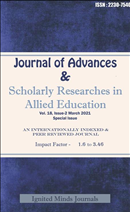Endotoxin: Indicator of Indoor Air Quality – A Case Study
Assessing Endotoxin Levels in Indoor Air: A Case Study on Bacterial Exposure
Keywords:
endotoxin, indoor air quality, limulus amebocyte lysate assay, gel-clot method, volumetric sampling technique, airborne viable counts, endotoxin-free water, false positive results, EUm3, inside sourceAbstract
Endotoxins may play an important role in the development of various symptoms in occupational environments where exposure to bacteria is prevalent. The standard analytical method for endotoxin is the Limulus amebocyte lysate (LAL) assay. The Gel-Clot method is one of the simplest, least expensive and has good sensitivity technique of LAL assay. In this study volumetric sampling technique has been applied for enumeration and quantification of airborne viable counts Endotoxin from indoor and outdoor air of school. An Endotoxin (Pyrogen)-free filter cassette with PTFE membrane filter has been used for air sampling. 240L air volume has been sampled for sampling of Endotoxin at the rate of 4LPM. Extraction of Endotoxins from the collected air samples has been done in Endotoxin-free water to avoid the evolving of false positive results during assay. Assay results indicate that Endotoxin level (EUm3) has been higher in indoor air than outdoor air. It is an indicator inside source of Endotoxins.Published
2021-03-01
How to Cite
[1]
“Endotoxin: Indicator of Indoor Air Quality – A Case Study: Assessing Endotoxin Levels in Indoor Air: A Case Study on Bacterial Exposure”, JASRAE, vol. 18, no. 2, pp. 55–57, Mar. 2021, Accessed: Jul. 03, 2024. [Online]. Available: https://ignited.in/jasrae/article/view/13039
Issue
Section
Articles
How to Cite
[1]
“Endotoxin: Indicator of Indoor Air Quality – A Case Study: Assessing Endotoxin Levels in Indoor Air: A Case Study on Bacterial Exposure”, JASRAE, vol. 18, no. 2, pp. 55–57, Mar. 2021, Accessed: Jul. 03, 2024. [Online]. Available: https://ignited.in/jasrae/article/view/13039








